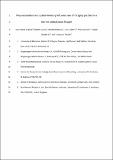Files in this item
Prey encounters and spatial memory influence use of foraging patches in a marine central place forager
Item metadata
| dc.contributor.author | Iorio-Merlo, Virginia | |
| dc.contributor.author | Graham, Isla | |
| dc.contributor.author | Hewitt, Rebecca | |
| dc.contributor.author | Aarts, Geert | |
| dc.contributor.author | Pirotta, Enrico | |
| dc.contributor.author | Hastie, Gordon Drummond | |
| dc.contributor.author | Thompson, Paul | |
| dc.date.accessioned | 2022-03-08T16:30:10Z | |
| dc.date.available | 2022-03-08T16:30:10Z | |
| dc.date.issued | 2022-03-09 | |
| dc.identifier | 278182860 | |
| dc.identifier | 8bc5becb-2234-4d91-94a8-dfd6aba12034 | |
| dc.identifier | 85125570581 | |
| dc.identifier | 000791273700002 | |
| dc.identifier.citation | Iorio-Merlo , V , Graham , I , Hewitt , R , Aarts , G , Pirotta , E , Hastie , G D & Thompson , P 2022 , ' Prey encounters and spatial memory influence use of foraging patches in a marine central place forager ' , Proceedings of the Royal Society B: Biological Sciences , vol. 289 , no. 1970 , 20212261 . https://doi.org/10.1098/rspb.2021.2261 | en |
| dc.identifier.issn | 0962-8452 | |
| dc.identifier.other | ORCID: /0000-0002-9773-2755/work/109766605 | |
| dc.identifier.other | ORCID: /0000-0003-3541-3676/work/109766909 | |
| dc.identifier.uri | https://hdl.handle.net/10023/25010 | |
| dc.description | This study was carried out as part of the Moray Firth Marine Mammal Monitoring Programme, a joint industry, academic and government strategic research project with funding from Beatrice Offshore Wind Ltd and Moray Offshore Renewables Ltd (MORL). | en |
| dc.description.abstract | Given the patchiness and long-term predictability of marine resources, memory of high-quality foraging grounds is expected to provide fitness advantages for central place foragers. However, it remains challenging to characterize how marine predators integrate memory with recent prey encounters to adjust fine-scale movement and use of foraging patches. Here, we used two months of movement data from harbour seals (Phoca vitulina) to quantify the repeatability in foraging patches as a proxy for memory. We then integrated these data into analyses of fine-scale movement and underwater behaviour to test how both spatial memory and prey encounter rates influenced the seals' area-restricted search (ARS) behaviour. Specifically, we used one month's GPS data from 29 individuals to build spatial memory maps of searched areas and archived accelerometery data from a subset of five individuals to detect prey catch attempts, a proxy for prey encounters. Individuals were highly consistent in the areas they visited over two consecutive months. Hidden Markov models showed that both spatial memory and prey encounters increased the probability of seals initiating ARS. These results provide evidence that predators use memory to adjust their fine-scale movement, and this ability should be accounted for in movement models. | |
| dc.format.extent | 10 | |
| dc.format.extent | 848503 | |
| dc.language.iso | eng | |
| dc.relation.ispartof | Proceedings of the Royal Society B: Biological Sciences | en |
| dc.subject | Area-restricted search | en |
| dc.subject | Spatial memory | en |
| dc.subject | Hidden Markov Model | en |
| dc.subject | Accelerometer | en |
| dc.subject | Harbour seals | en |
| dc.subject | Repeatability | en |
| dc.subject | GC Oceanography | en |
| dc.subject | HA Statistics | en |
| dc.subject | DAS | en |
| dc.subject | SDG 14 - Life Below Water | en |
| dc.subject.lcc | GC | en |
| dc.subject.lcc | HA | en |
| dc.title | Prey encounters and spatial memory influence use of foraging patches in a marine central place forager | en |
| dc.type | Journal article | en |
| dc.contributor.institution | University of St Andrews. School of Biology | en |
| dc.contributor.institution | University of St Andrews. Centre for Research into Ecological & Environmental Modelling | en |
| dc.contributor.institution | University of St Andrews. Sea Mammal Research Unit | en |
| dc.identifier.doi | https://doi.org/10.1098/rspb.2021.2261 | |
| dc.description.status | Peer reviewed | en |
This item appears in the following Collection(s)
Items in the St Andrews Research Repository are protected by copyright, with all rights reserved, unless otherwise indicated.

